| |
To start off you are going to need some kind metal
container, a large sweet tin, biscuit tin or empty paint can is ideal. |
|
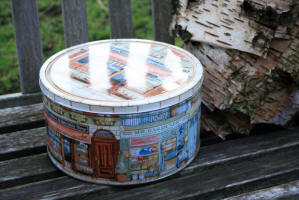 |
| |
Make a whole in the bottom of the tin in the centre. |
|
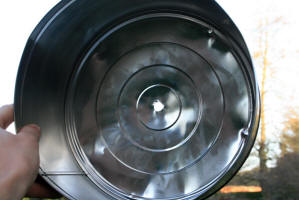 |
| |
Collect your bark from dead birch trees, there is no need
to go stripping fresh bark! You can take advantage of that bark that is
too tatty to use for crafts. I got all the bark i needed from just one
small fallen tree. Tear the bark into strips as high as the height of the
tin, then begin rolling them up into a bundle.
Note: Dead birch
trees are a common home to nesting woodpeckers, mice and other creatures,
do not destroy their habitat! |
|
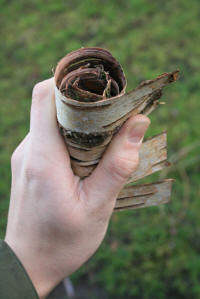 |
| |
You will notice that once the bark is rolled up tightly it
wants to spring back out again, so every so often i tie a piece of string
around the bark to make life easier. |
|
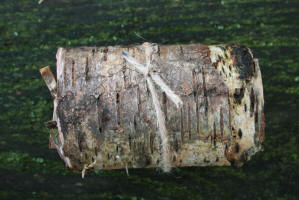 |
| |
Keep rolling on pieces of bark onto your bundle until it
is as wide as the tin. When you put the bark into the tin you can always
shove more bark into the areas that are not tightly packed.
If the bark
was not rolled up and packed into the tin in this way the tar would not
escape from the bark as easily. Notice that the bark is the same way up in
the tin as on a tree. |
|
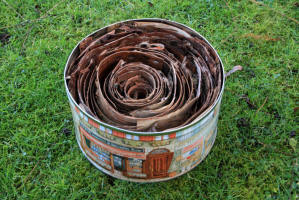 |
| |
Now its time to prepare to extract! At your fire site dig
a small whole in the ground and insert another small metal container, i
find a baked bean can is best, then fill in the gaps around the can with
earth. |
|
 |
| |
The whole in the large tin needs to go directly above this
can. Make sure the rim of the baked bean can and the base of the tin are
flush together. You can move more earth up and around the sides of your
large tin to prevent it from moving out of alignment. |
|
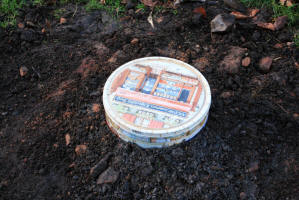 |
| |
Now light a fire on top of the tin. When the bark inside
the tin is heated to extreme temperatures it releases the tar as a thick
vapour. This vapour will go down through the whole and distil in the baked
bean can underneath. The process takes a few hours for all of the tar to
extract properly. For this time you should keep the fire well maintained. |
|
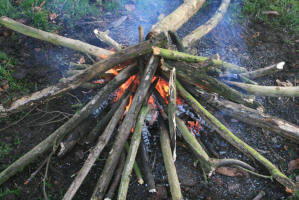 |
| |
After a few hours have passed and the fire has nearly
burnt out, all that will be left in the tin will be the charred bark. Lift
the tin off to reveal the tar in the baked bean can. My tin full of bark
typically collects just a little less than half a can of tar.
Note:
Do not remove the tin from its position while the fire is still
burning around it as the vapours are very flammable and catch alight
easily. |
|
 |
| |
The tar will be very runny at this stage and is good to
use as a preservative for wood and I've heard it has several medicinal
properties. If you want to make your tar into glue then keep on reading... |
|
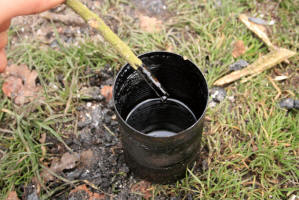 |
| |
You will need to reduce the tar down by simmering it next
to the fire. It doesn't take a lot of heat to get this stuff bubbling so
don't get it too close to the fire otherwise it will set on fire, if this
does happen don't worry, just move the can away from the embers and it
should go out again |
|
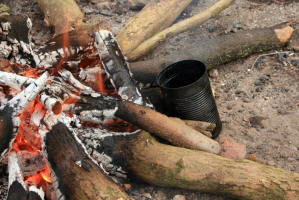 |
| |
Obviously you can't touch the can whilst it is that hot so
i find a stick with a small split in the end is a very handy tool. Push
the stick onto the rim of the can so that rim is held in the middle of the
split. Carry on reducing the tar down. Dip the end of a small stick into
the tar every so often and let it cool, you can test how tacky the tar is
with your fingers. It might take another few hours until the tar begins to
set on the end of the dip stick. When the tar does start to set take the
can away from the fire and let it cool for a while. You can now tell for
sure whether it sets hard enough. |
|
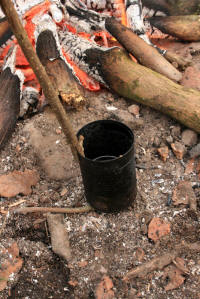 |
| |
You can scrape out the tar from the can while it is still
warm and gooey, and then mould it onto the end of a stick. When you need
to use some of the tar simply hold your tar loaded stick over a flame for
a second or two until it goes gooey again and then apply it quickly to the
surfaces you want to stick. It sets very fast so you've got to be quick.
Have fun!
|
|
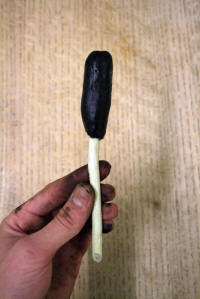 |
| |
|
|
|
| |
|
|
|
